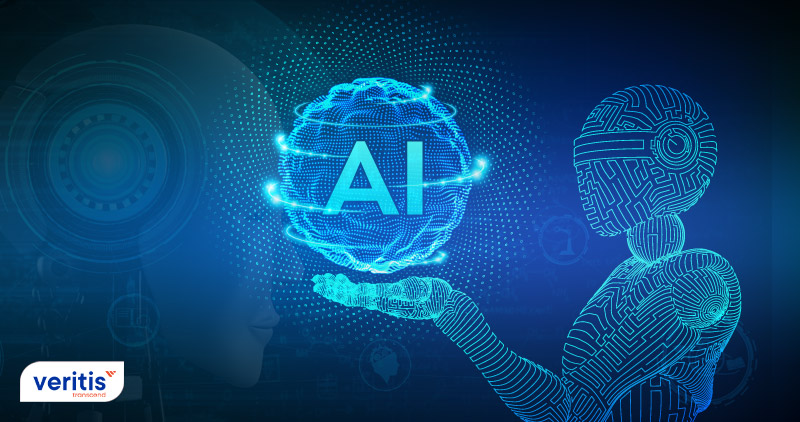
Artificial Intelligence (AI) works by combining advanced algorithms with vast datasets to enable machines to perceive information, learn from patterns, and make decisions at speeds and scales that often surpass human capability. The process involves data collection, algorithmic training, pattern recognition, and continuous optimization, powered by technologies such as machine learning (ML), deep learning (DL), natural language processing (NLP), and computer vision.
In an era where data has become a strategic asset, leaders are under increasing pressure to make accurate, timely, and informed decisions. AI has emerged as a transformative enabler, converting raw data into actionable insights and enabling leaders to make informed decisions in complex, rapidly evolving environments.
By understanding the mechanics of AI from data ingestion to model deployment, decision makers can leverage this technology not only to optimize operations but also to unlock new business models, inspiring innovation and driving the business forward.
Leaders are particularly interested in learning if AI implementation will make their jobs more accessible, as it is predicted that it will revolutionize the organization significantly. While most are enthusiastic, some do not want to make more complex decisions. The cornerstone of their reputation as good leaders is their capacity to make wise decisions without using sophisticated technologies.
Modern business leaders must cope with numerous moving components daily, including remote employment and emerging technologies. With artificial intelligence in business, owners don’t typically need to spend hours evaluating each row, column, or cell of data to reach conclusions. Thanks to AI decision making, business leaders can now tackle two issues at once: massive datasets can be evaluated immediately, and cognitive biases are eliminated from the process, ensuring that only objective, fact based information is used to make decisions.
The good news is that since decision makers need to add discretion to machine projections, AI is highly unlikely to make their jobs easier. Nevertheless, the primary goal of AI will unavoidably impact business decision making in some ways, and the precise impact is still unknown. AI implementation can change how executives make decisions.
Request a Personalized Consultation
Useful link: What is Edge Machine Learning?
What is Artificial Intelligence?
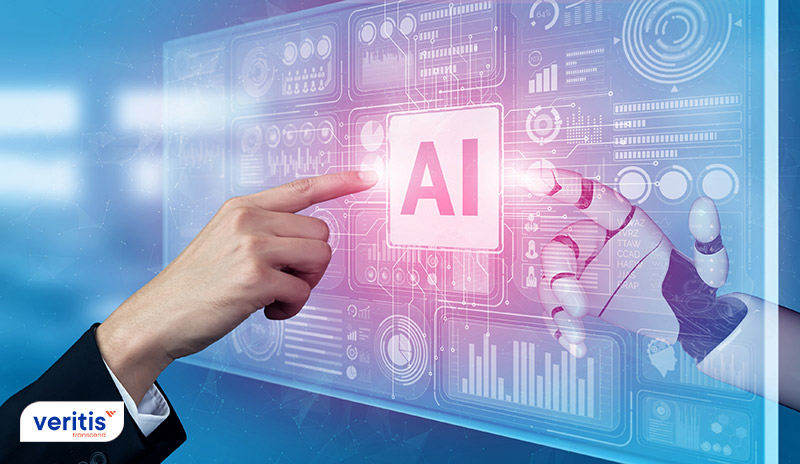
Artificial intelligence is a technology that enables robots and software to replicate human intellect by learning from experience through iterative processing and algorithmic training. Visual perception, speech recognition, decision making, and word translation are all tasks that typically require human intelligence. But today, computer programs can employ their intelligence and skill to accomplish these issues.
When a group of mathematicians and scientists gathered in June 1965 at Dartmouth to debate the possibility of creating a computer that could genuinely think, this sort of intelligence was born. Although they had no idea what it would be called or how it would operate, their conversations there lit the fuse that launched artificial intelligence. The evolution of this intellect has had highs and lows since the “Dartmouth workshop,” as it is known. Years passed, during which the notion of creating an intelligent computer was dropped, and little to no effort was made to this form of intelligence. In recent years, a frenzy of effort has been made to create and incorporate this fascinating, intelligent technology into daily life.
Introduction to AI: AI is a form of intelligence used to address issues, find answers, provide information, predict outcomes, and make tactical recommendations. Because of its transformative potential, successful AI adoption has become crucial for contemporary corporations and other organizations seeking to innovate and stay competitive.
The field of artificial intelligence has grown over time because of technological developments. The three recognized types of AI spectrum encountered today are:
1) Automation Intelligence
Simply put, it entails completely automating the process while removing humans. Examples include self driving cars and autonomous robots.
2) Assisted Intelligence
It concentrates on automating simple chores and taking machines from assembly lines as an example.
3) Augmented Intelligence
Symmetry is a byproduct of enhanced intelligence. The procedure is reciprocal. Machines are to be used to learn from human input. Humans, meanwhile, rely on insightful data to make accurate decisions.
Useful link: AI Powered, ML Driven: The New DevOps Trend!
How Does AI Work? The Core Process Explained
AI operates through a systematic, iterative cycle designed to enhance accuracy and relevance over time.
1) Data Collection and Aggregation
AI systems collect structured data (e.g., transaction logs, sensor readings) and unstructured data (e.g., images, text, voice) from multiple internal and external sources.
2) Data Preprocessing and Cleaning
Ensuring Data Quality for Accurate Predictions, raw data is meticulously cleaned, normalized, and formatted for analysis and interpretation. This crucial step eliminates inconsistencies and guarantees the dataset’s readiness for analysis, thereby enhancing the accuracy of AI predictions.
3) Algorithm Selection and Model Training
Using machine learning or deep learning, algorithms are trained on historical data to identify relationships, trends, and anomalies.
4) Inference and Decision Execution
Once trained, the AI maturity models confidently processes new data to make predictions, generate classifications, or provide recommendations, thanks to the role of algorithms in decision making.
5) Continuous Learning and Optimization
AI models evolve by integrating new data, incorporating feedback loops, and refining performance metrics. This continuous learning and optimization process ensures that AI models remain adaptable to the ever changing business and market conditions.
Recognize When to Use AI for Decision Making
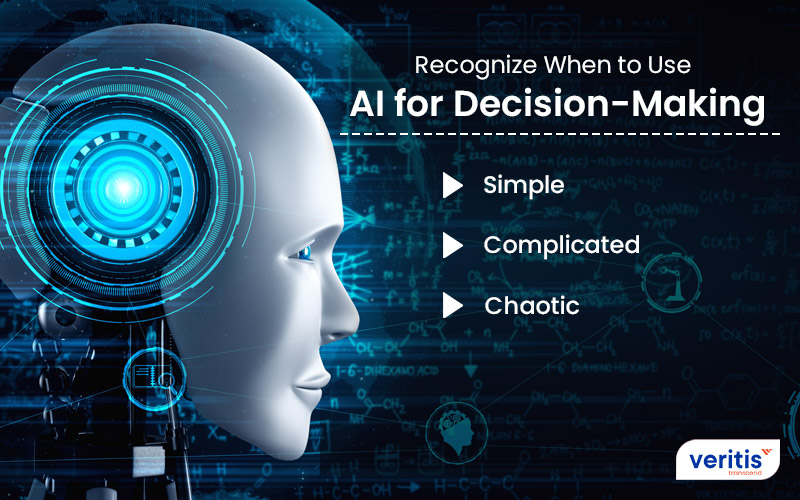
The ability or necessity of AI applications to automate, augment, or support a choice depends on two essential factors: complexity and time or how quickly the business needs a conclusion.
The time dimension describes the interval between the organization’s initial awareness of risk or opportunity and its actual decision making and action taking. For instance, the time frame for high frequency stock trading may be just a few microseconds; for pay decisions, it might take weeks; and for strategic mergers and acquisitions, it can take months or even years.
The so called Cynefin framework, for instance, depicts a continuum of complexity that ranges from simple to complicated, complex, and chaotic. In the context of AI for IT Operations, this framework can be used to identify where AI can best be applied to streamline decision making processes, especially in complex and time sensitive IT environments, where AI can quickly analyze vast amounts of data to provide actionable insights and automate decision making.
1) Simple
Simple situations are steady, predictable, and have a clear cause and effect relationship. Payroll processing and contact center routing are two examples of artificial intelligence.
2) Complicated
Complicated situations need knowledge or analysis to determine causes and effects, frequently employing knowledge of a tried and true problem solving method. Instances include asset management, insurance fraud, and conducting marketing promotions.
Complex situations often entail a variety of relationships and dependencies. Thus, the practical analysis calls for a systemic or holistic approach and simulations to show how choices could impact distant elements. A few examples of artificial intelligence include supply chain disruptions.
3) Chaotic
Unknown causes and consequences lead to uncertain or dynamic interdependencies in chaotic environments. Minor adjustments could have disproportionately large effects. Making decisions is highly challenging and necessitates trial and error learning. Instances include battlefields, natural calamities, and financial market crises.
Useful link: All You Need to Know about Artificial Intelligence as a Service (AIaaS)
Artificial Intelligence Decision Making at Multiple Levels
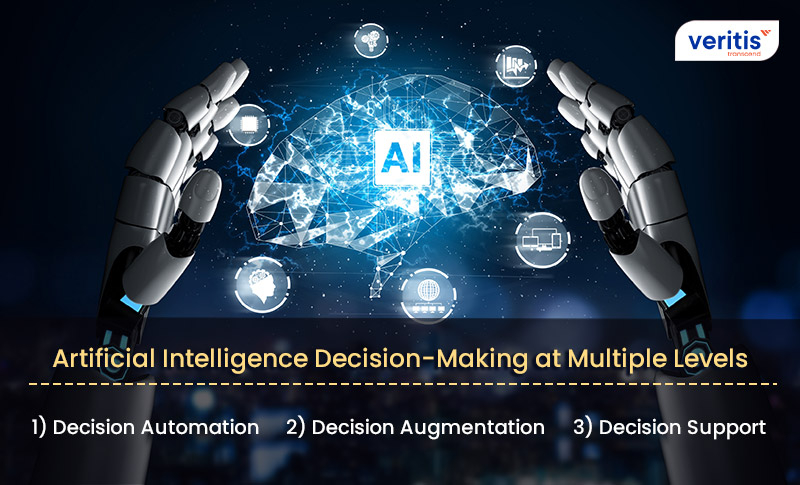
Humans may not always make the best decisions or do so consistently, yet they nonetheless possess valuable skills. Similarly, the main goal of AI is to have a position in decision making. Decision automation, decision augmentation, and decision support represent the degrees to which artificial intelligence and analytics applications can pursue quicker, more reliable, more flexible, and higher quality judgments at scale.
The decisions made at multiple stages of the decision making process fluctuate depending on who decides. The decisions made at numerous stages of the decision making process differ depending on who makes them in the end, as well as the analytics techniques employed at those stages:
1) Decision Automation
The system decides to use predictive or prescriptive analytics. Its benefits include quick, scalable, and consistent decision making.
2) Decision Augmentation
The system suggests a decision or many options to human actors using prescriptive or predictive analytics. Its advantages lie in the synergy between human expertise and AI’s ability to evaluate large amounts of data and deal with complexity quickly.
3) Decision Support
Descriptive, diagnostic, or predictive analytics support the decision making of human employees. Using human knowledge, skill, and common sense, including “gut feel” and emotions, along with data driven insights and insights from other sources, is where it derives most of its advantages.
AI’s Ability to Make Decisions Rely on Complexity and Time
Leaders can evaluate individual decisions and decide whether it would be worthwhile to automate, enhance, or support them by combining the variables of time and complexity.
Automation is a desirable alternative for quick decisions that must be made in seconds to 15 minutes. Decision augmentation is a possibility for complex judgments or ones that must be made in minutes or hours. Leaders can investigate decision support for complex, even chaotic, and non urgent decisions.
In every one of these cases, the top AIOps solutions provider applies. Leaders should anticipate that as technology develops, the boundaries of what may be feasibly automated will progress along the axis of complexity over time.
Useful link: 10 Ways Artificial intelligence (AI) is Transforming DevOps
10 Aspects of How AI and Decision Making Works
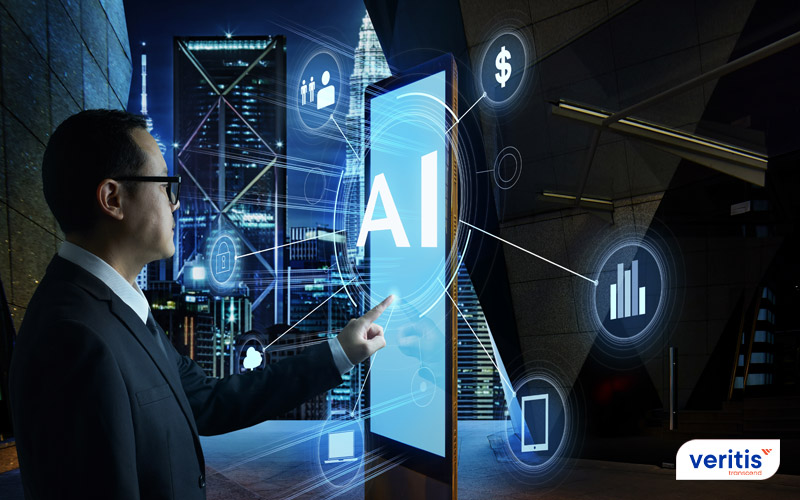
1) Leaders Can Identify Opportunities and Risks
Leaders must be aware of both opportunities and risks to make the best decisions. AI Risk Management can help by analyzing data and identifying patterns that reveal potential chances and threats. For instance, advanced AI can monitor rival activity, such as new product launches, discount strategies, and price comparisons. This insight empowers you to adapt your methods effectively, enhancing your competitive edge.
2) Prediction
Many companies are already employing predictive analytics to improve decision making through data mining. With predictive analytics, organizations can anticipate outcomes by analyzing datasets and making informed predictions about future events.
Machine learning, another method used in predictive analytics, is a top AIOPS services component. Data mining focuses on finding patterns in large datasets, while machine learning involves building systems that learn from data and act on it independently.
Using the data presented, decisions can be taken regarding things like:
- Based on cost effectiveness and possible ROI, certain advertisements are displayed.
- How to improve the buying process by examining consumer behavior.
- How to lower churn among customers.
3) Fewer Decisions to Make
Numerous psychological studies have demonstrated that we must make many decisions quickly. Our quality suffers because our mental energy gradually depletes.
Placing candies and snacks at the pay register at supermarkets is an example of artificial intelligence and how it might be used. Marketers know that you will make decisions throughout your little shopping trip and that by the time you’re finished, you won’t be able to resist the sugar rush.
Algorithms can make endless daily decisions, each as precise as possible, because they are not susceptible to decision fatigue. As a result, executives who employ the most advanced AI will have an advantage since they can surpass human weaknesses.
4) Multi Tasking
Executives often need to consider various considerations while making complex decisions. When there is too much information to evaluate, the decision maker may become overwhelmed and make unwise choices.
On the other hand, a machine can manage several inputs without being overwhelmed or confused. All required is a collection of instructions or programs that direct the machine to use probability and recommend or carry out the most logical conclusion.
5) Enhanced Human Judgement
The decision maker will always be a human until we can give AI emotional intelligence. Uncomplicated jobs that don’t require emotional intelligence and experience the two elements that serve as the foundation of judgment in business can be handed to a machine. However, humans must do the more important ones, which have a higher chance of error and financial penalty. Another crucial component of sound judgment that cannot be left to top AI solution providers, according to Ajay A., Joshua G., and Avi G., is the capacity to make trade offs when appropriate. This is so that one may make an informed decision. This includes thorough awareness of the organization’s values, goals, and risks.
However, using AI operations in decision making is still possible and desirable. Its function is to inform humans of all the information and scenarios that might occur.
6) AI Guides Leaders in Better Communication
Effective communication is essential to any organization’s success. After all, it’s the primary means by which leaders express their vision and guide their team. Leaders can pinpoint crucial issues with their team members and produce quick solutions using the most advanced AI. They can also monitor sentiment in communication channels to spot possible areas for improvement.
7) AI Can Detect the Root Cause of Issues
Leaders must find the root of the issue to solve it effectively. They may now use AI to comprehend their company’s data far deeper. By identifying artificial intelligence trends and patterns, AI provides them with real time insights and feedback, ultimately assisting them in finding the underlying causes of issues and proposing solutions.
8) AI Can Reduce Workload by Time Taking or Automating Repetitive Tasks
Your daily activities involve different repetitive and time consuming chores, even if you aren’t aware of them. Artificial intelligence (AI) can automate monotonous jobs so you may concentrate on more important things. A leader can use AI operations to automate reviewing and approving expense reports, for instance, if they need to examine numerous of them.
9) Leaders Can Make Decisions in Difficult or Ambiguous Circumstances
Leaders frequently must make judgments without complete access to the facts. AI operations can help them by presenting potential scenarios and results based on historical data and recent artificial intelligence trends. While they don’t have all the answers, it guides leaders to make more informed business judgments.
10) AI Assists Executives in Staying Current with Emerging Trends and Technologies
What was effective yesterday might not be effective today since the world constantly changes. To stay current with trends and advancements, an AIOPS strategy may help leaders in various ways. For instance, AI can keep an eye out for pertinent terms and phrases on social media and other online platforms, allowing leaders to spot emerging artificial intelligence trends early on, make decisions that are in keeping with the times, and stay one step ahead of the competition.
Machine Learning vs Deep Learning
| Aspect | Machine Learning | Deep Learning |
| Definition | Algorithms learn from data to make predictions or decisions. | Neural networks with multiple layers analyze data in complex, abstract ways. |
| Data Requirement | Works well with smaller datasets. | Requires massive datasets for effective training. |
| Processing Approach | Relies on feature engineering by humans. | Automatically extracts features from raw data. |
| Example Use Cases | Fraud detection, recommendation systems. | Facial recognition, language translation, and self driving cars. |
AI in Decision Making: Industry Applications
- Healthcare: AI assists in early diagnosis, medical imaging interpretation, and personalized treatment planning.
- Finance: Detects fraudulent transactions, evaluates credit risk, and optimizes investment portfolios.
- Manufacturing: Enables predictive maintenance, quality control, and process optimization.
- Retail: Enhances demand forecasting, dynamic pricing, and personalized marketing campaigns.
- Energy: Enhances grid efficiency, predicts outages, and optimizes the integration of renewable energy.
How Does AI Make Decisions?
AI’s decision making process blends statistical analysis, probabilistic modeling, and pattern recognition.
Example: Fraud Detection in Banking
1) Input Analysis: The AI model analyzes transaction data in real time.
2) Pattern Recognition: It compares the transaction against historical patterns for anomalies.
3) Risk Scoring: Assigns a probability of fraud based on statistical models and algorithms.
4) Action Trigger: Automatically blocks or flags the transaction for human review.
This human in the loop approach ensures AI decisions are augmented with human judgment where necessary, enhancing the balance between efficiency and accuracy. It also provides a crucial reassurance to the audience about the importance of human oversight in AI decision making, thereby instilling a sense of trust in the system.
Case Study: Empowering Decision Making in Automotive with AI Driven Operations
A global automotive firm partnered with Veritis to improve operational efficiency and decision making across its IT infrastructure using AI.
Challenge: The company experienced delays in identifying system issues, resulting in performance disruptions and reactive decision making.
Solution: Veritis implemented an AI powered AIOps solution, enabling real time monitoring, predictive analytics, and automated incident management, empowering leaders with timely and actionable insights.
Results:
- Faster, data informed decisions through real time visibility
- Improved system reliability with proactive issue resolution
- Streamlined operations using intelligent automation
This case illustrates how AI enables leaders to shift from reactive to proactive strategies, making more intelligent and faster decisions that drive operational excellence.
Read the Full Case Study: Transforming Automotive Operations with AIOps
Conclusion
The future holds many intriguing changes. Although AI might not always simplify processes, it will significantly help streamline decisions for better procedures and a more flexible business.
Business vendors face only one risk: failing to use AI. However, as more companies incorporate AI into their IT stacks, they become more competitive in terms of how focused their marketing is, how correctly they can predict future demand, and how rapidly they can pivot when issues develop.
Veritis, the Stevie Award winner, is the preferred choice for artificial intelligence outsourcing requirements. We have offered services and solutions to Fortune 500 and emerging organizations. Contact us to receive a customizable solution that fits your business.